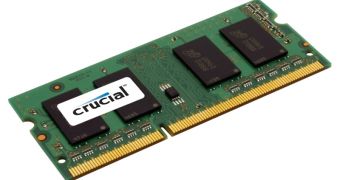Lexar Media came forth and issued an official press announcement in which it reveals that both its desktop and notebook memory lines have received an update in the shape of the Crucial 8GB DDR3-1333MHz memory.
Lexar Media has been making and selling memory products for desktops and laptops ever since it appeared.
Its latest sojourn into this field is in the form of two memory solutions of 8 GB capacity each.
One of them is the Crucial 8GB DDR3-1333MHz UDIMM, intended for desktops, while the other is the Crucial 8GB DDR3-1333MHz SODIMM, for laptops.
They are designed to support the second generation of Intel Core i7 and i5 central processing units, the kind found in mainstream and high-end systems, not that they won't work with anything else of course.
“We’re seeing the total maximum density of desktop and laptop system memory grow as a direct result of the size and complexity in software applications,” said Michael Moreland, worldwide product manager for Crucial DRAM.
“The new Apple iMac, for example, can utilize up to 32GB of system memory, enabling intense computing power for applications such as video-, photo-, or music- editing software. High-density memory isn’t just for servers anymore; consumers also want to get the most performance out of their system.”
Capacities of 32 GB on mobile PCs are all well and good, but the new Crucial products will most benefit those notebooks and motherboards with a limited number of slots.
The SODIMM modules work on 1.35V, while the desktop ones have the 1.5V specification. This low power draw implies less heat, not just longer battery life for notebooks.
Also, Lexar made sure to build the newcomers in such a way that they comply with RoHS specifications.
Kits of 16 GB to 24 GB are all available for purchase through Crucial, Dabs, Misco and other partners.

 14 DAY TRIAL //
14 DAY TRIAL //